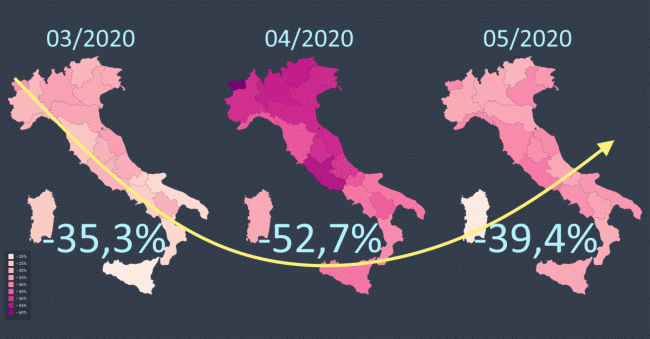The Covid-19 pandemic and the consequent restrictive measures had a devastating effect on the Italian economy in the first months of 2020. What was the impact on cash circulation? We tried to clarify between defeatist rumors about a 80% collapse and more optimistic ones tending to minimization, thanks to the incontrovertible support of the data, bearing in mind that Knox platform is used to manage the cash of about 55% of the cash points in Italy (bank branches, retail groups, ATMs).
The results must be read taking into account the containment measures adopted to control the infection and their territorial application, for the details see the endnote.
The measures had a very limited effect in February (due to their application to a territory of about 50,000 inhabitants), and a partial effect in March, whereas the whole month of April was subject to the most restrictive provisions. This is perfectly reflected in the numbers analyzed.
| Month | Branches | ATMs | Retail | NCB | Total |
| January | 1,79% | -18,24% | 2,05% | -5,85% | -1,75% |
| February | 9,18% | -9,07% | 11,92% | -15,50% | 2,45% |
| March | -31,06% | -48,49% | -32,04% | -31,82% | -35,35% |
| April | -48,99% | -62,61% | -53,51% | -53,25% | -52,66% |
| May | -35,82% | -45,75% | -44,68% | -38,47% | -39,39% |
The total data of January and February can be perfectly superimposed onto those of the year 2019 (the different number of working days may explain the gap), however there are some differences between the various types of cash points: the trips to and from the National Central Bank (Banca d’Italia) were significantly lower in January and February due to the progressive spread of the compensations between banks within the same cash center (NHTO), thanks to the adoption of the proper Knox module, whereas the cash increase from large retailers balanced the reduction in the banking sector (branches and ATMs).
It is interesting to note that, although the measures covered the entire national territory (apart from the small area subject to the first lockdown), there were different reductions from region to region, as the following images show:
If we superimpose the graph of April (representing the decrease during the lockdown period) on that of the infection ratio, we get an almost perfect match, with the exception of the Lazio region. This can be explained by the peculiarities of the city of Rome, which was struck less severely by the epidemic but was forced to close (partially or completely) numerous activities based in its territory, such as public administrations.
Taking a look at the month of May even if the drop is still present, we see the first effects of the reopening with reversal of the trend. From the data collected in the first half of June we observe a further increase in the use of cash: despite the fact that the opening of many tourist activities has been postponed, we may expect a further 10% recovery.
Note: history of the issued measures to contain the outbreak.

SHARE
I cookie ci aiutano a migliorare l’esperienza del nostro sito web. Continuando la navigazione, accetti l’utilizzo dei cookie da parte nostra.